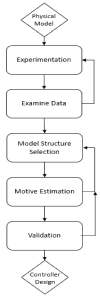Integration of Inertial Sensors in a Lower Limb Robotic Exoskeleton
- PMID: 35746340
- PMCID: PMC9229016
- DOI: 10.3390/s22124559
Integration of Inertial Sensors in a Lower Limb Robotic Exoskeleton
Abstract
Motion assistance exoskeletons are designed to support the joint movement of people who perform repetitive tasks that cause damage to their health. To guarantee motion accompaniment, the integration between sensors and actuators should ensure a near-zero delay between the signal acquisition and the actuator response. This study presents the integration of a platform based on Imocap-GIS inertial sensors, with a motion assistance exoskeleton that generates joint movement by means of Maxon motors and Harmonic drive reducers, where a near zero-lag is required for the gait accompaniment to be correct. The Imocap-GIS sensors acquire positional data from the user's lower limbs and send the information through the UDP protocol to the CompactRio system, which constitutes a high-performance controller. These data are processed by the card and subsequently a control signal is sent to the motors that move the exoskeleton joints. Simulations of the proposed controller performance were conducted. The experimental results show that the motion accompaniment exhibits a delay of between 20 and 30 ms, and consequently, it may be stated that the integration between the exoskeleton and the sensors achieves a high efficiency. In this work, the integration between inertial sensors and an exoskeleton prototype has been proposed, where it is evident that the integration met the initial objective. In addition, the integration between the exoskeleton and IMOCAP is among the highest efficiency ranges of similar systems that are currently being developed, and the response lag that was obtained could be improved by means of the incorporation of complementary systems.
Keywords: Imocap-GIS; UDP protocol; actuators; exoskeleton; inertial sensors; lower limb; motion cycle.
Conflict of interest statement
The authors declare no conflict of interest.
Figures















Similar articles
-
A Recurrent Deep Network for Gait Phase Identification from EMG Signals During Exoskeleton-Assisted Walking.Sensors (Basel). 2024 Oct 16;24(20):6666. doi: 10.3390/s24206666. Sensors (Basel). 2024. PMID: 39460147 Free PMC article.
-
Lower Limb Exoskeleton for Rehabilitation with Flexible Joints and Movement Routines Commanded by Electromyography and Baropodometry Sensors.Sensors (Basel). 2023 Jun 1;23(11):5252. doi: 10.3390/s23115252. Sensors (Basel). 2023. PMID: 37299979 Free PMC article.
-
Integration, Sensing, and Control of a Modular Soft-Rigid Pneumatic Lower Limb Exoskeleton.Soft Robot. 2020 Apr;7(2):140-154. doi: 10.1089/soro.2019.0023. Epub 2019 Oct 11. Soft Robot. 2020. PMID: 31603736
-
Lower Limb Exoskeleton Sensors: State-of-the-Art.Sensors (Basel). 2022 Nov 23;22(23):9091. doi: 10.3390/s22239091. Sensors (Basel). 2022. PMID: 36501804 Free PMC article. Review.
-
Flexible lower limb exoskeleton systems: A review.NeuroRehabilitation. 2022;50(4):367-390. doi: 10.3233/NRE-210300. NeuroRehabilitation. 2022. PMID: 35147568 Review.
References
-
- Antwi-Afari M.F., Li H., Edwards D.J., Pärn E.A., Seo J., Wong A.Y.L. Biomechanical analysis of risk factors for work-related musculoskeletal disorders during repetitive lifting task in construction workers. Autom. Constr. 2017;83:41–47. doi: 10.1016/j.autcon.2017.07.007. - DOI
-
- Ma Y., Wu X., Yang S.X., Dang C., Liu D.-X., Wang C., Wang C., Chen C. Online Gait Planning of Lower-Limb Exoskeleton Robot for Paraplegic Rehabilitation Considering Weight Transfer Process. IEEE Trans. Autom. Sci. Eng. 2021;18:414–425. doi: 10.1109/TASE.2020.2964807. - DOI
-
- Sun Y., Tang Y., Zheng J., Dong D., Chen X., Bai L. From sensing to control of lower limb exoskeleton: A systematic review. Annu. Rev. Control. 2022;53:83–96. doi: 10.1016/j.arcontrol.2022.04.003. - DOI
MeSH terms
LinkOut - more resources
Full Text Sources
Miscellaneous

